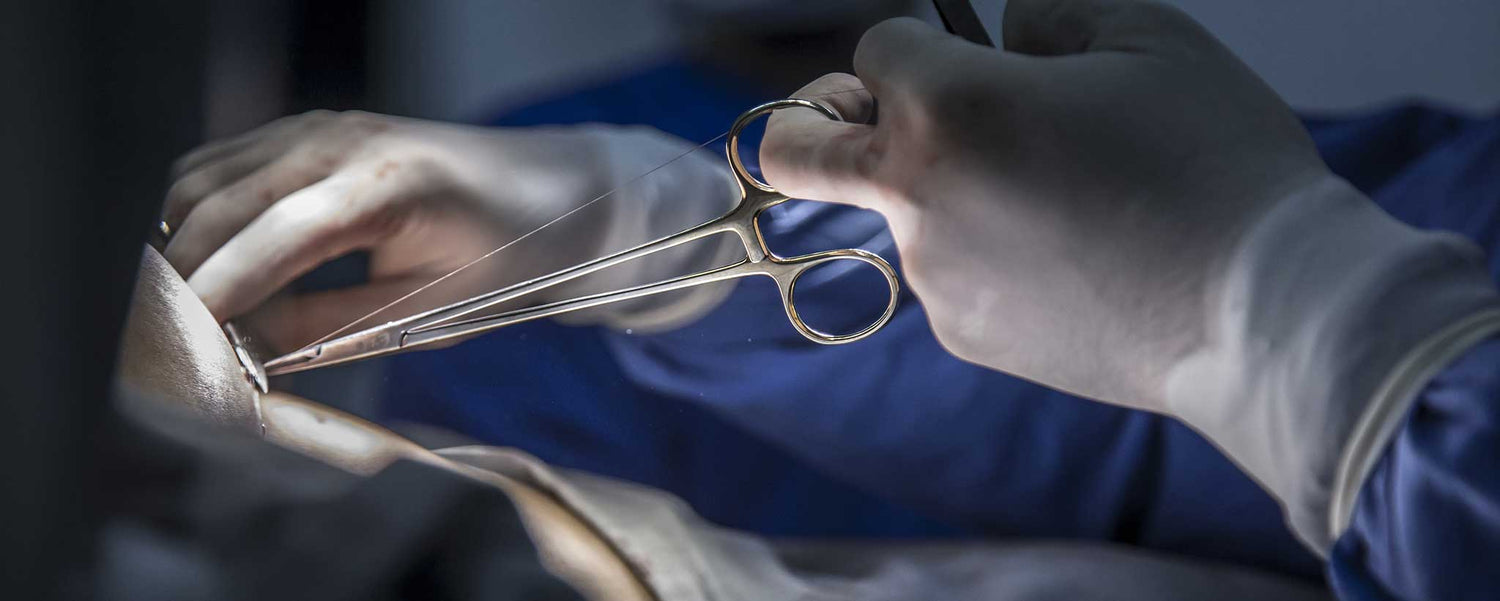Radical mastectomies are rarely performed. Progress provides hope for what is the most common type of cancer in the U.S.
Battling Genes
⚠️ Use Discretion: Graphic human anatomy.
Cancer is a group of diseases characterized by the uncontrolled growth and spread of abnormal cells. A personal or family history of breast cancer and inherited BRCA1 or BRCA2 genetic mutations increases risk. BRCA1 germline mutation is associated with unilateral triple-negative breast cancer. The tumor(s) must be removed or growth halted to preserve life.
Many treatments are available, including lumpectomy (partial mastectomy), mastectomy, chemotherapy, radiation therapy, targeted hormone therapy, and immunotherapy (FDA approved March 2019).
Modern Breast Cancer Treatment
As a patient, a breast cancer diagnoses can feel depressing, emotionally and physically exhausting, even devastating. Within the past 150 years, mastectomies have advanced from solely radical to more common nipple-and-areola-sparing surgeries. Early treatment yields optimum results.
Prior to, and throughout the beginning of the 20th century, the 5-year survival rate of all breast cancer was zero percent, despite surgical intervention. Now the average 10-year survival rate for women with invasive breast cancer is 83 percent. The average 5-year survival rate is 90 percent with proper treatment.
If located only in the breast, the 5-year survival rate of women with breast cancer is 99 percent. Sixty-two percent of cases are diagnosed at this stage. If the cancer has spread to the regional lymph nodes, the 5-year survival rate is 85 percent. When cancer has spread to a distant part of the body (Stage IV metastasis), the 5-year survival rate is 27 percent.
The history of mastectomies reaches beyond the past century and a half. Tales of barbaric surgeries sans anesthesia and follow-up treatment are not for the faint of heart. By comparison, even uncommon bilateral mastectomies today are civilized.
Apparent progress in treatment methods provides hope for what is, according to the American Cancer Society, the most common type of cancer in the United States. The following is a synopsis of the excellent compilation by Matthew D. Freeman, Jared M. Gopman, and C. Andrew Salzberg.
Evolution of Mastectomies
3000 BCE—According to Egyptian documents likely originating between 3000 BCE and 1500 BCE, breast tumors were generally treated with simple cautery and no post-op management.
1500s—German surgeons made major contributions in the field of surgery. Despite detailed techniques and case reports, few mastectomies were being performed during this time due to the lack of skilled surgeons. Patients were also discouraged by excessive disfigurement and morbidity associated with the procedure itself.
1700s—In the 18th century, major contributions in lymph node mapping are attributed to Pieter Camper (b. 1722) and Paolo Mascagni (b. 1752). Le Dran’s colleague, Jean Petit (b. 1674), recommended breast, pectoral muscle, and axillary lymph node removal in the management of breast cancer. However, reconstructive capabilities were lacking. Performing these procedures without antiseptic, the chest wall was often left disfigured with a large gaping wound. As you might imagine, mortality was high.
1800s—In 1804, Japanese surgeon Seishu Hanaoka performed the world’s first procedure under general anesthesia—a mastectomy. This paved the way for more comfortable surgeries.
William S. Halsted published his work with radical mastectomy from the 50 cases operated at Johns Hopkins between 1889 and 1894. He recommended en bloc resection of all suspected tissues including the pectoralis major muscle and lymph nodes of the axilla, which became known as the “Halsted radical mastectomy”—a popular technique that prevailed for 70 years.
Graphic photo: Halsted radical mastectomy
According to the Halsted-Meyer theory, the major pathway for breast cancer dissemination was through the lymphatic ducts. Therefore, it was thought that performing wider and more mutilating surgeries that removed a greater number of lymph nodes would result in greater chances of cure. (We now understand that sentinel node dissection reduces the chance of lymphedema with better patient outcomes.)
The discovery of X-rays by William Roentgen in 1895 changed the landscape of medicine and led to the shift of breast cancer treatment during the 20th century from purely surgical to the multiple modalities employed today.
1900s—In 1937, Geoffrey Keynes of London demonstrated that radiation therapy and mastectomy had equivocal outcomes in the management of breast cancer, but the therapy did not gain popularity and radical mastectomy continued as the standard of care into the 1940s.
Graphic photo: Ductal carcinoma mastectomy
By the 1970s, advances in cancer biology, pathology, and disease understanding corroborated the concept of female breast conservation surgery. The current landscape of breast cancer treatment encomapasses a wide assortment of imaging modalities, chemotherapy, targeted hormonal therapy, improvements in radiation targeting, and targeted immunotherapy.
1900s–Present—Today, oncology surgeons rarely perform radical mastectomies, as a 1977 study by the National Surgical Adjuvant Breast and Bowel Project (NSABP), led by Bernard Fisher, showed that there was no statistical difference in survival or recurrence between radical mastectomies and less invasive surgeries.
Graphic photo: Breast-conserving surgery
It was not until 1991 that Toth and Lappert coined the skin-sparing mastectomy for breast cancer treatment. During the operation on a woman, all breast tissue and nipple-areola complex (NAC) is removed in an elliptical incision pattern, with additional removal of skin overlying the tumor if superficially located.
The remaining breast skin is preserved to facilitate breast reconstruction. Sentinel lymph node biopsy or axillary dissection, if necessary, are performed through the same incision following removal of the breast mound.
Going a step further than a cosmetically appealing breast is one that retains areola sensation. One method is a deep inferior epigastric perforator (DIEP) flap. A sensory nerve supplying the donor flap is isolated, preserved, and coapted to the transected intercostal nerve. “Not all patients are good candidates for DIEP reconstruction.
Pre-mastectomy breast size, adipose, and skin availability, time in surgery and costs are all considerations. We are exploring additional options for patients that might need them,” says Risal Djohan, MD, Vice Chair of the Department of Plastic Surgery at Cleveland Clinic.
Although breast cancer continues to rank highest among frequently diagnosed cancers in U.S. women, mortality is decreasing yearly with an overall regression of 36 percent from 1989 to 2012.

Unilateral mastectomy scar.
Rare male breast cancers account for less than 1 percent of all cancers in men and about 1 percent of all invasive breast cancers. “Unfortunately, our knowledge of how to treat male breast cancer is pretty much just extrapolated from our knowledge of treating female breast cancer,” said Shannon L. Puhalla, MD, assistant professor of medicine at the University of Pittsburgh Medical Center Cancer Center.
Perform self examinations and get regular cancer screening to prevent late-stage diagnosis. Male or female, if you are in the battle, you can win! The tools and technologies available to ob-gyn doctors and oncology surgeons significantly improve the odds of survival. In fact, this is the best time for treatment in medical history.
To support the writing of scholarly articles about women, ClinicalPosters sells human anatomy charts, scientific posters, and other products online. You may sponsor specific articles or remit a small donation.
ClinicalPosters sells human anatomy charts, scientific posters, and other products online to offset expense of the writing useful articles about women. Slide extra posters into DeuPair Frames without removing from the wall.
Show your support by donating, shopping for ClinicalPins, or leaving an encouraging comment to keep the research going.
To support the writing of useful articles about women, ClinicalPosters sells human anatomy charts, scientific posters, and other products online. You may sponsor specific articles or remit a small donation.
ClinicalPosters sells human anatomy charts, scientific posters, and other products online to offset expense of the writing useful articles about women. Slide extra posters into DeuPair Frames without removing from the wall.
ClinicalPosters sells human anatomy charts, scientific posters, and other products online. You may remit a small donation.
You can support the writing of useful articles about women by sponsoring specific articles or remitting a small donation. Visible content is optimized for device size.






 Romance & Health Intertwine. Fall in love with a captivating romance miniseries that explores the essence of well-being. Become a ClinicalNovellas library member for heartwarming tales.
Romance & Health Intertwine. Fall in love with a captivating romance miniseries that explores the essence of well-being. Become a ClinicalNovellas library member for heartwarming tales.




